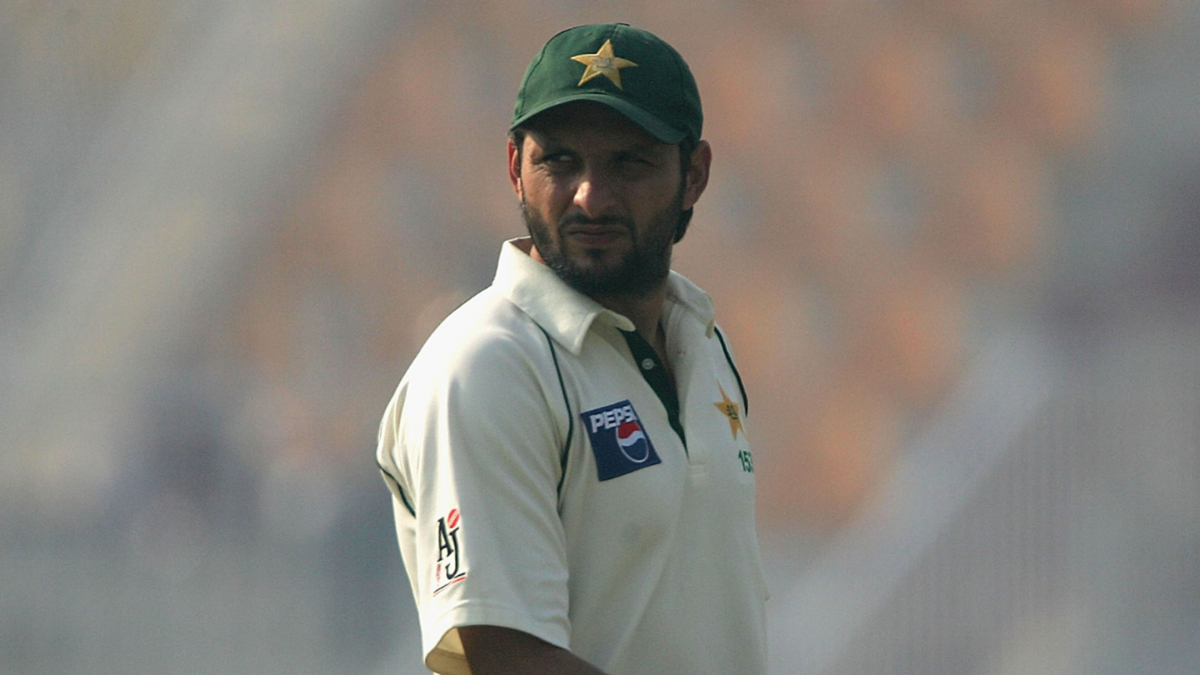
Shahid Afridi, Pakistan’s new interim chief selector, carries the legacy of a great short-format career. But his Test career was unique and memorable in its own way, and if not for its interruptions, had the potential to make him an all-format great.
How do you remember Shahid Afridi, the cricketer? An amusingly compulsive hitter of the white ball, smashing anything and everything that came in his sight? Or a smart, peerless leg-spinner, whose simple yet effective way of targeting the stumps saw him scythe through batting line-ups? Both of those images perfectly fit, but there were more layers to the man they call ‘Boom Boom’.
One of them, a mere footnote to his great, grand T20 and one-day career, was his time with the Test team.
It was a wild ride. When he debuted, Aamer Sohail was still the Test captain, Australia had won the World Cup just once, and Allan Donald and Curtly Ambrose were the highest-ranked Test bowlers. The last of his 27 Tests came 12 years later, months after England had won the T20 World Cup – the first time. He bowled alongside both Wasim Akram and Mohammad Amir. He spanned eras, despite playing just 27 Tests. Averaging more than 36 with the bat and less than 36 with the ball is impressive. With a cut-off of 40 wickets, only 27 all-rounders have done so. But as ever with Afridi, the numbers don’t tell the true tale.
There were several gaps in the middle: he played no Tests from December 2000 to February 2002, then again from May 2002 to March 2005. The gap between his 26th and 27th Test was four years. And yet, despite a decade-long series of ins and outs, Afridi actually stacked up formidable numbers.
For a player notorious for caring little about batting averages in one-dayers, Afridi average of 39.08 was the sixth-best among all Pakistan Test batters in the 2000s (minimum 10 innings). For the same criteria, the average went up further when he batted in the middle order: at 49.71, only Mohammad Yousuf and Inzamam-ul-Haq averaged more in the 2000s (positions No.4 to No.7).
The open Test fields gave Afridi the clarity to express when and how he wanted to. It’s no surprise that the strike rate of 92.16 was the highest in the 2000s for anyone who played ten or more innings. But it was the late Nineties where it really felt he could make a difference in the Test whites.
The debut came after 66 ODIs, then a record, and against a star-studded Australia in Karachi. He didn’t do much with the bat, but picked up a five-wicket haul, including the scalps of the Waugh brothers. Next year (his second Test), he put in a performance for the ages, playing a significant part with the bat in the historic India-Pakistan Chennai Test. Opening the batting, he blazed to a second-innings 141 – half the side’s total – playing in his own inimitable style to bruise India’s attack. It wasn’t all boom boom: he manoeuvred the field, playing out 191 deliveries across a five-hour long knock.
The possibilities of having an all-rounder like Afridi were limitless, but the problem was, as always, consistency. There was no clear role either: Pakistan were happy to shuffle him up and down the order, sometimes even mid-Test. His 84 against Sri Lanka in the 1999 Asian Test Championship came after two golden ducks and a mid-match promotion and four dropped catches. Till the end of 2000 though, the shuffling continued, and he played as low as No.9.
The second (of many comings), came in 2002, when Afridi was recalled to the top of the order, smashing a century against West Indies in a 244-run win. However, Pakistan weren’t getting enough from Afridi, the leg spinner. At that point, his bowling strike rate was in the high sixties. The emergence of Danish Kaneria didn’t help his case.
But Afridi kept coming back. In the mid-2000s, Pakistan’s middle order needed some experience, and Afridi was recalled, going on to have two successful years. In 12 Tests from 2005 to 2006, he averaged 43.00 and hit three centuries. His 122, against West Indies in Bridgetown, was more than 40 per cent of the team’s total. Then came back-to-back centuries against India. The bowling, too, remained good for a second spinner.
When you finally thought Afridi’s Test career had truly kicked off, the man himself decided to step away, taking an indefinite sabbatical to concentrate on the 2007 World Cup.
He came back only for one more Test, in 2010, a difficult year in many ways for Pakistan, a game that summed up both Afridi and the team. Appointed captain for all three formats after a four-year exile, he scored 31 & 2 and took one wicket against Australia. Clearly unimpressed with his four-ball stay in the second innings, and the slog that brought it to a close, Afridi retired mid-game, saying he didn’t have “the temperament to play Test cricket”. “I’m not capable of playing Test cricket and if I play cricket like this, then it’s better to leave.”
Captain for one game, slogging freely and retiring partway through, it brought to an end a Test career like no other. Short and long both, packed with true entertainment, but also incomplete in so many ways.








